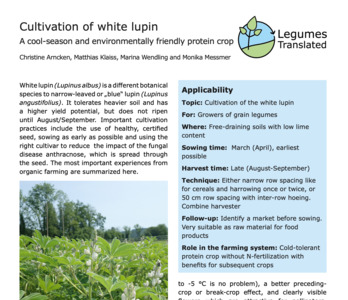{Tool} Cultivation of white lupin – a cool-season and environmentally friendly protein crop. Creator(s): Arncken, Christine; Klaiss, Matthias; Wendling, Marina and Messmer, Monika. Issuing Organisation(s): FiBL - Research Institute of Organic Agriculture. Legumes Translated Practice Note, no. 4. (2020)
|
PDF
- Published Version
- English
(English version)
2MB | |
|
PDF
- Published Version
- German/Deutsch
(German version)
1MB | |
![[thumbnail of White Lupin PN_coverphoto.png]](/39219/3.hassmallThumbnailVersion/White%20Lupin%20PN_coverphoto.png)  Preview |
Image (PNG)
- Cover Image
- English
1MB |
Document available online at: https://zenodo.org/record/3888324
Summary in the original language of the document
White Lupin is the second most valuable protein crop, after soybean. It tolerates heavier soil and has a high yield potential. Avoiding anthracnose is the key to success in white lupin and essential cultivation practices include the use of healthy, certified seed, sowing as early as possible and using the right cultivar. The most important experiences from organic farming are summarized in this Legumes Translated practice note, including practical information on the ideal site, inoculation, sowing, cultivation and harvest. The tool is specific to organic farmers in Europe.
Summary translation
Weisse Lupinen (Lupinus albus) sind eine andere botanische Art als schmalblättrige oder „blaue“ Lupinen (Lupinus angustifolius). Sie vertragen schwerere Böden und haben ein höheres Ertragspotential, reifen allerdings erst im August/September. Wichtig für ihren Anbau ist die Verwendung von gesundem, zertifizierten Saatgut, eine möglichst frühe Aussaat und die richtige Sortenwahl, um eine Infektion mit der Pilzkrankheit Anthraknose, die über das Saatgut verbreitet wird, zu vermeiden.
In diesem Legumes Translated-Merkblatt werden die wichtigsten Erfahrungen aus dem ökologischen Anbau zusammengefasst.
| EPrint Type: | Practice tool |
|---|---|
| Teaser: | Learn how to successfully cultivate the white lupin. |
| What problem does the tool address?: | White lupin (Lupinus albus) does not ripen until August/September and is threatened by anthracnose. |
| What solution does the tool offer?: | Important cultivation practices which reduce the impact of the fungal disease, anthracnose, are provided. |
| Country: | Switzerland |
| Type of Practice Tool: | Leaflets & guidelines |
| Theme: | Crop specific |
| Keywords: | Soil; Soil qaulity; nitrogen fixation; Crop production; crop management; arable farming ; Legumes |
| Agrovoc keywords: | Language Value URI English soil http://aims.fao.org/aos/agrovoc/c_7156 English soil quality http://aims.fao.org/aos/agrovoc/c_a9645d28 English nitrogen fixation http://aims.fao.org/aos/agrovoc/c_5196 English crop management http://aims.fao.org/aos/agrovoc/c_16094 English crop production http://aims.fao.org/aos/agrovoc/c_5976 English arable farming http://aims.fao.org/aos/agrovoc/c_36528 English legumes http://aims.fao.org/aos/agrovoc/c_4255 |
| Subjects: | Soil > Soil quality Crop husbandry > Production systems > Cereals, pulses and oilseeds Crop husbandry |
| Research affiliation: | Switzerland > FiBL - Research Institute of Organic Agriculture Switzerland > Crops > Arable crops > Legumes European Union > Horizon 2020 > Legumes Translated European Union > Organic Farm Knowledge |
| Horizon Europe or H2020 Grant Agreement Number: | 817634 |
| Related Links: | https://www.legumestranslated.eu/practice-notes, https://organic-farmknowledge.org/tool/39219, https://www.facebook.com/permalink.php?story_fbid=868996773949461&id=313194372863040, https://twitter.com/farm_knowledge/status/1360148515733798925 |
| Project ID: | ofk |
| Deposited By: | Forschungsinstitut für biologischen Landbau, FiBL |
| ID Code: | 39219 |
| Deposited On: | 10 Feb 2021 13:06 |
| Last Modified: | 02 May 2024 10:31 |
| Document Language: | English, German/Deutsch |
| Status: | Published |
Repository Staff Only: item control page

 Download Statistics
Download Statistics Download Statistics
Download Statistics
